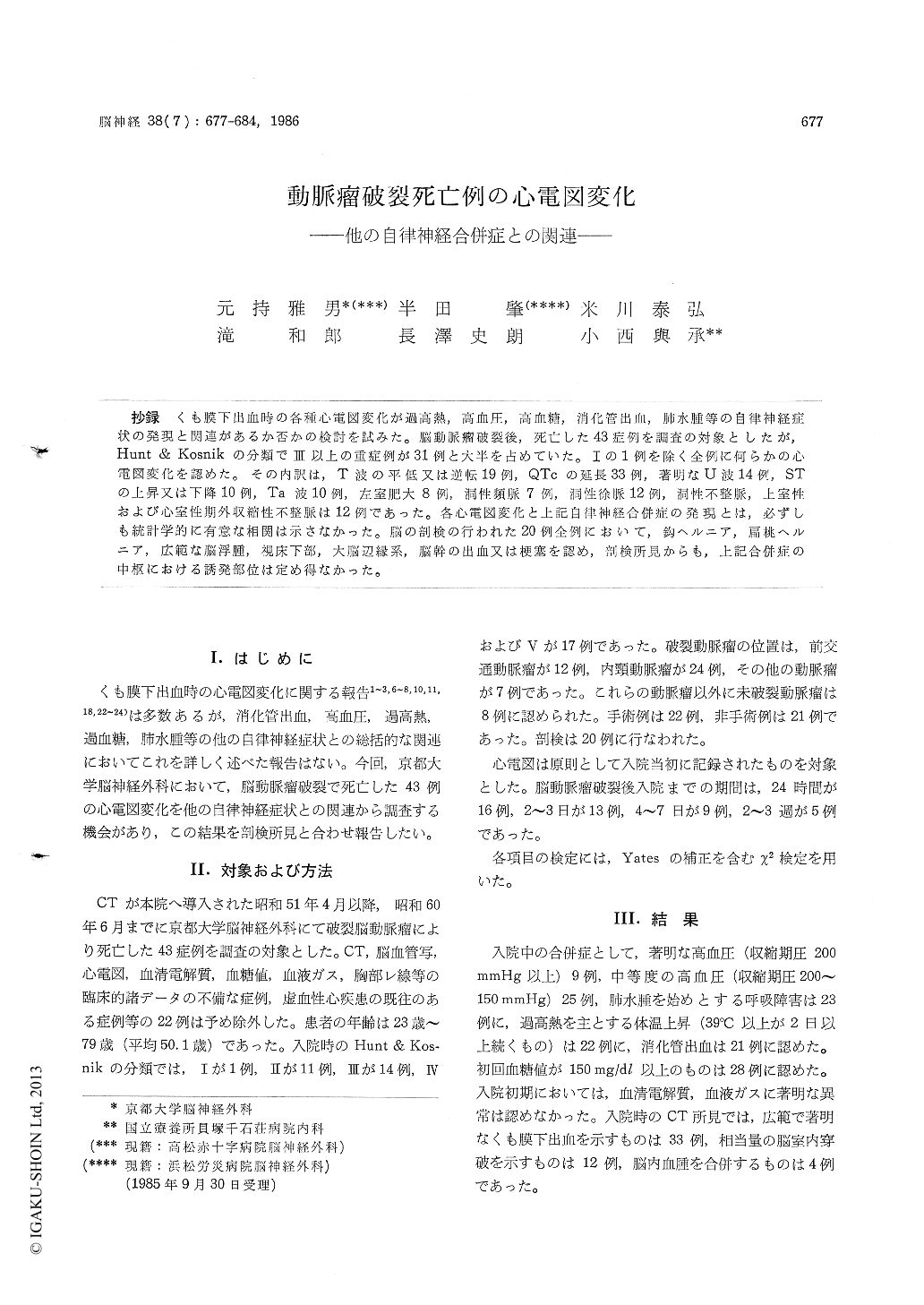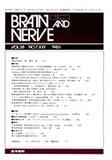Japanese
English
- 有料閲覧
- Abstract 文献概要
- 1ページ目 Look Inside
抄録 くも膜下出血時の各種心電図変化が過高熱,高血圧,高血糖,消化管出血,肺水腫等の自律神経症状の発現と関連があるか否かの検討を試みた。脳動脈瘤破裂後,死亡した43症例を調査の対象としたが,Hunt&Kosnikの分類でIII以上の重症例が31例と大半を占めていた。Iの1例を除く全例に何らかの心電図変化を認めた。その内訳は,T波の平低又は逆転19例, QTCの延長33例,著明なU波14例, STの上昇又は下降10例,Ta波10例,左室肥大8例,洞性頻脈7例,洞性徐脈12例,洞性不整脈,上室性および心室性期外収縮性不整脈は12例であった。各心電図変化と上記自律神経合併症の発現とは,必ずしも統計学的に有意な相関は示さなかった。脳の剖検の行われた20例全例において,鈎ヘルニア,扁桃ヘルニア,広範な脳浮腫,視床下部,大脳辺縁系,脳幹の出血又は梗塞を認め,剖検所見からも,上記合併症の中枢における誘発部位は定め得なかった。
Forty three expired cases due to ruptured cere-bral aneurysm were studied in electrocardiographic alterations with special reference to other compli-cations of the autonomic nervous system. The cases with past history of ischemic cardiovascular disease had been excluded. The age of the pa-tients ranged between 23 to 79 years old (average 50.1 years old). The clinical condition of the pa-tients according to Hunt & Kosnik classification I in 1 case, II in 11 cases, III in 14 cases, and IV & V in 17 cases. The duration between the aneu-rysm rupture and admission was within 24 hours in 16 cases, 2 to 3 days in 13 cases, 4 to 7 days in 9 cases, and 2 to 3 weeks in 5 cases. The site of ruptured aneurysms was anterior communicating artery in 12 cases, internal carotid artery in 24 cases, and others in 7 cases. The direct surgeries to the aneurysms were performed in 22 cases, and not done in 21 cases.
The electrocardiographic alterations were found as follows: flat or inverted T in 19 cases, pro-longed QTc in 33 cases, manifest U in 14 cases, ST elevation or depression in 10 cases, Ta (atrial T) in 10 cases, left ventricular hypertrophy in 8 cases, sinus tachycardia in 7 cases, sinus brady-cardia in 12 cases, and arrhythmias with SVPC or VPC (supraventricular or ventricular premature contraction), or sinus arrhythmia in 12 cases.
Prolonged QTc, and flat or inverted T were most often found in the cases with ruptured an-eurysm of the anterior communicating artery, and next in those with the internal carotid artery, and least often in those with others. Atrial T (Ta) was found in the reverse order of the frequency. Prolonged QTc and sinus bradycardia were more often found in the presence of cerebral vasospasm. Manifest U and arrhythmia were more accom-panied with prolonged high body temperature. The higher in systolic arterial blood pressure, the more often recognized were flat or inverted T, left ventricular hypertrophy and arrhythmia. At-rial T was more often found in higher glucose level. There was no relation between GI bleeding and ECG alterations checked. Atrial T was recog-nized in ten cases most often with ruptured an-eurysm of IC-PC, usually in the ECG lead of II, III, and F.
Brain cuttings done in 20 cases showed uncal and/or tonsillar herniation (s), diffuse cerebral ede-ma, hemorrhage and/or infarction in the hypotha-lamus, limbic system, brain stem and so forth in all the cases in various degree. These changes were too diffuse to get informations from regarding central triggering site (s) provoking those compli-cations of the autonomic nervous system.

Copyright © 1986, Igaku-Shoin Ltd. All rights reserved.


